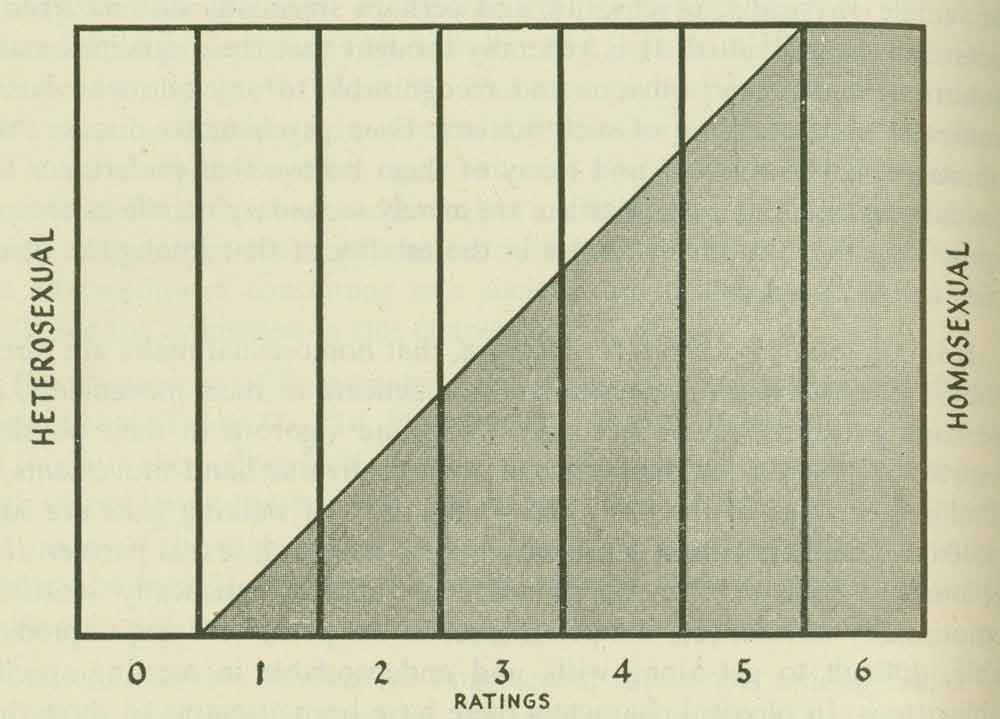

The Scale's Treatment Of Bisexuality And Asexuality Has Come Under Fire How do you define "predominantly," "incidentally," and "more than incidentally"? Importantly, Kinsey took into account both behavior and feelings of attraction to determine your "Kinsey number," so being attracted to members of the same sex still counted, even if you were in a monogamous straight relationship and never acted on the flirtation. Note that there's a lot of wiggle room here. Here are the categories of Kinsey's scale, in the official terminology:Ġ- Exclusively heterosexual with no homosexualġ- Predominantly heterosexual, only incidentally homosexualĢ- Predominantly heterosexual, but more than incidentally homosexualĤ- Predominantly homosexual, but more than incidentally heterosexualĥ- Predominantly homosexual, only incidentally heterosexual
#KINSEY SCALE TEST REAL FULL#
The Kinsey Institute, which aims to continue Kinsey's research into human sexuality, has the entire spectrum in full on its website. So if nothing else, consider this an important history lesson. But it's been one of the basics of queer identity since the '50s.

You aren't meant to come away from this guide thinking that the Kinsey is the only option for self-definition if anything, questioning it is a pretty valid way of determining how you feel about sexual identity, fluidity, attraction, and experience. But many of us still do - and the Kinsey is a neat way to outline it simply. But the main thrust of it is that humans don't really fit into categories like "straight" or "gay" - which you wouldn't think we'd need to have explained at this point. Rather, Kinsey positioned people on the seven-point scale - where a rating of 0 meant that you were "exclusively heterosexual" and a rating of 6 meant that you were "exclusively homosexual" - based on hours of interviews. Not shabby for something you can sketch out on the back of a bar napkin.įirst things first: The Kinsey Scale is not an actual test. You could even call it one of the most significant ideas in the history of human sexuality. The Kinsey Scale - an early method of describing the spectrum of human sexuality, created by pioneering sexuality researcher Alfred Kinsey - may not be the most accurate tool we have to define our sexuality, but it's certainly been one of the most historically influential. If the mention caught you off-guard (and led you to sneakily google it when you thought your opponent wasn't looking), consider this your guide. Read more about the Klein Sexual Orientation Grid in this article from the American Institute of Bisexuality.If you've ever gotten into an argument with someone about sexual orientation, chances are that one of you eventually brought up the Kinsey Scale. Read about the background of the Kinsey Scale from the Kinsey Institute at Indiana University. (Figure 2)īoth the Kinsey Scale and the KSOG are ways of measuring and representing bisexuality as existing along a continuum of sexual identities. The KSOG incorporates a variety of elements, including the possibility that a person’s sexual identity will change over time, and it includes emotional and romantic preferences as well as sexual attraction/behavior (The Klein Sexual Orientation Grid, 2014). More recently, the Klein Sexual Orientation Grid (KSOG) was developed by the founder of the American Institute of Bisexuality to represent a nuanced view of sexual orientation, including bisexuality. Kinsey and his colleagues developed the Kinsey Scale in the 1940s, to measure and portray sexual attraction/behavior as occurring along a continuum, with a number of people falling somewhere between exclusive heterosexuality and exclusive homosexuality (The Kinsey Scale, 2017).

Alfred Kinsey was one of the first researchers to explore bisexuality in the U.S.


 0 kommentar(er)
0 kommentar(er)
